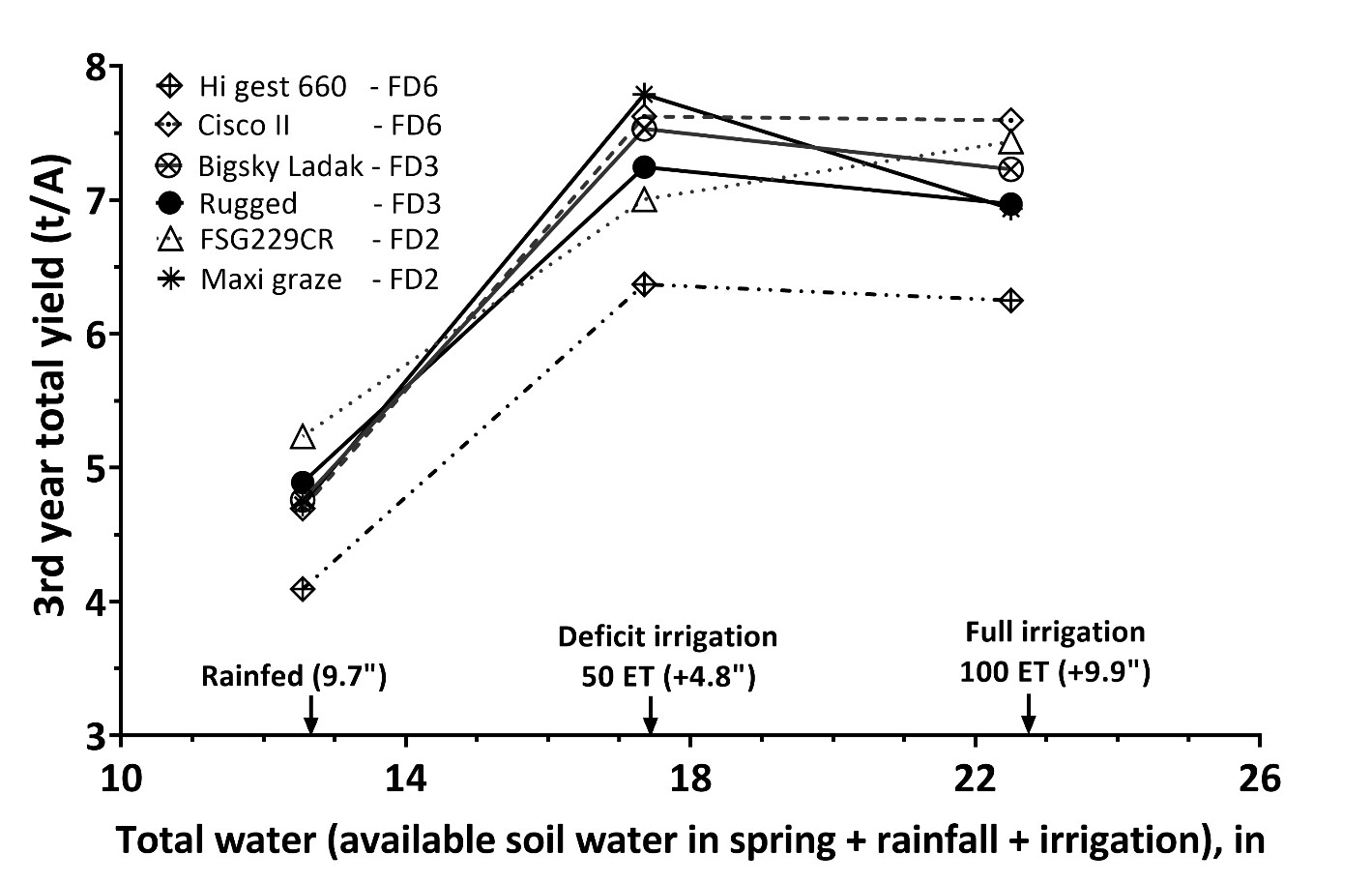Assessing Alfalfa Yield and Quality Under Different Irrigation Strategies to Increase Production Efficiencies (third year)
Link to Alfalfa Yield and Quality Printable PDF

Objective:
To evaluate yields of alfalfa of various fall dormancy under differing moisture
Personnel:
J.A. Torrion, Amanda Shine, Eeusha Nafi
Summary:
These results presented are from the third-year (2020) of alfalfa trial established in 2018. Specific management information is provided in Table 1. The six alfalfa varieties of three fall dormancies (FD): 2, 3, and 6, were managed under three water regime environments: rainfed, 50% evapotranspiration (50ET), and 100% evapotranspiration (100ET).
As expected, yield increased significantly with increase in water availability (from rainfed to irrigation). However, there was an observed interaction with the alfalfa varieties and total water availability (Figure 1). For example, FSG229CR - an FD 2, outperformed the other varieties under rainfed condition. Also, the less dormant Cisco II- an FD 6, performed better under both irrigated conditions. However, another less dormant FD 6 – Hi gest 660 (low-lignin variety) did not perform well compared with its counterpart FD-6 (Cisco II) and the rest of the varieties across moisture regime this year. Total yield of Maxi graze- an FD 2 decreased by 11.5%, while its counterpart FD-2 (FSG229CR) increased by 5.4% under full irrigation condition compared with deficit irrigation.
The cultivar-specific yield response to water regimes this year means that each variety does have different water productivity values. Overall, the deficit irrigation treatment (50ET) consistently showed the highest water use efficiency (aka water productivity) shown in Table 2.
Table 1. Management information |
|||
| Planted: | 5/21/2018 | Field Location: | R7 |
| Emerged: | 5/28/2018 | Cutting dates (2020): | 6/27-28 (1st cut); |
| 7/30-31 (2nd cut); | |||
| 9/4, 9/11, 9/115 (3rd cut) | |||
| Seeding rate: | 25 seeds/ft2 | Total irrigation (50 ET): | 4.8 inches |
| Previous crop: | Barley | (100 ET): | 9.95 inches |
| Herbicide: | 7/2: Pursuit | Total precipitation: | 9.7 inches (4/15-9/25) |
| Insecticide: | None | Soil type: | Creston silt loam |
| Fungicide: | None | Soil residual nutrient (NO3-, P, K lb/A): | 23-20-190 (fall, 2018) |
| Weed control: | Manual weeding | Nutrient fertilizer applied ( N, P2O5, K20 lb/A): | 4/29/20: 100 lbs K2O on 50 and 100 ET blocks |

Figure 1.
Moisture regime interaction with alfalfa varieties. Irrigation application in the 50% evapotranspiration (50ET) occurred at the same time with the 100ET. Specifically, the 50ET received half of what was applied under 100ET per irrigation event.
Table 2. Water productivity of the rainfed and the irrigated treatments based on evapotranspiration demand (ET). Total water productivity includes initial soil moisture in spring + rainfall + irrigation. |
||
| Water regimes | Total water productivity | Applied irrigation water productivity |
| -----------------------tons/inch water----------------------- | ||
| Rainfed | 0.37 | - |
| Deficit irrigation (50ET) | 0.41 | 0.52 |
| Full irrigation (100ET) | 0.32 | 0.24 |
| Mean | 0.37 | 0.38 |
